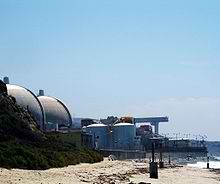Crazifornia: Will it be Gov. Brownout?
By Laer Pearce
On Jan. 31, the strained California electricity grid marked the one year anniversary of the shutting down of Unit 3 at the San Onofre Nuclear Generating Station. The reactor was taken off-line when pinhole leaks were discovered in water pipes that carry heated radioactive water from the reactor to a steam generator.
The process of shutting down the reactor caused a much publicized release of radioactive steam — which contained about as much radioactivity as one year’s worth of emissions from your home smoke detector. But its long-term effect is more worrisome and less publicized.
The negative impact on California’s electricity grid was made worse by the routine shut-down of San Onofre’s Unit 2 earlier in January for routine maintenance and refueling. It has been off-line ever since because it’s now under the same regulatory hold as Unit 3. (SONG’s Unit 1 was decommissioned in 1992 following 24 years of uneventful service.)
When the two reactors are on-line, they generate up to 2,200 megawatts of power — enough for 1.4 million homes and businesses. Besides supplying so much power, the power stations are critical to California’s electrified life because they provide essential voltage support. Voltage support functions like water pressure in a water system. A minimum amount of pressure is needed within the system to ensure water will move through pipes, just as a minimum amount of voltage support is necessary to ensure electrons will move through power lines.
Without sufficient voltage support, California will experience brownouts and blackouts when demand peaks. Yet last summer, with San Onofre completely off-line, we dodged brownouts. Southern California Edison, which co-owns the plant with San Diego Gas & Electric and the city of Riverside, attributes that to the lucky alignment of four factors:
* New transmission lines switched on in 2012, so more power could be brought in from elsewhere;
* Different places in the service area had hot spells at different times;
* Edison was able to buy power from AES’ 900 megawatt natural gas-fired power plant in Huntington Beach;
* People conserved.
This year, only the fourth factor remains certain. Businesses and individuals will conserve power when it’s needed, especially since many have traded 100 percent reliability for lower rates. But no new transmission lines will come on-line this year, and last year’s Southern California weather, which saw hot spots migrating from location to location instead of covering the entire region, was unusual and not likely to be repeated.
AES Plant
What about the AES generating plant in Huntington Beach? It’s still there and the natural gas pipeline is still connected to its boilers. So why is it that we won’t be able to get even a single kilowatt of power from it when we’ll need it this summer? The answer can be found in California’s fixation on single-handedly saving the planet from the ravages of global warming.
One keystone to that quixotic quest is California’s first-in-the-nation state-run cap and trade program, which kicked off last November with the state’s first carbon credit auction. AES decided to sell the plant’s carbon credits at the auction, and because it did, no greenhouse gases can be emitted from its stacks this year. As far as California’s electricity grid is concerned, the plant might as well have been wiped out by a tsunami.
Could it really be that a slip of paper from a harebrained and costly auction — an auction that will not accomplish one whit of planet-saving — may result in brownouts and blackouts this summer? The answer to that question, unfortunately but not at all unexpectedly, is yes.
With long-time environmentalist Gov. Jerry Brown at California’s helm, green-leaning Democrat super-majorities in both houses of the state legislature and entrenched eco-crats ruling the state’s regulatory agencies, the AES plant is certain to remain shuttered no matter what the summer may bring. The carbon crusaders simply cannot afford to allow a high-profile precedent to undercut the centerpiece of their carbon-fighting battle so early in the auction’s history.
So, should brownouts and blackouts return to California this summer, remember this: It wasn’t really problems at the San Onofre nuclear power plant that caused them. It was problems in the thinking of California’s leadership.
Laer Pearce, a veteran of three decades of California public affairs, is the author of “Crazifornia: Tales from the Tarnished State.”
Related Articles
Big twist in San Diego stadium saga
A stadium task force named by San Diego Mayor Kevin Faulconer has been holding a rapid-fire series of meetings with
Good and bad news on bullet train(s) front
March 24, 2013 By Chris Reed As I wrote last week, the budget that Senate Democrats have embraced contains so
Forbes publisher assesses state decline
Feb. 16, 2010 By KATY GRIMES In a poignant and often funny talk, Forbes Magazine Publisher Rich Karlgaard believes this




